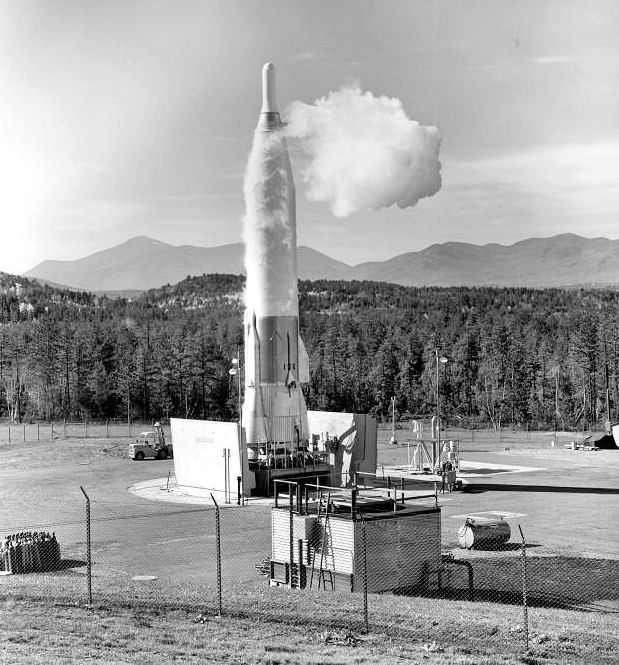Watching the (Doomsday) Clock
With recovery just getting started from Hurricane Harvey and with Hurricane Irma set to unleash its 24 megatons of fury upon the residents of Florida, the word “apocalyptic” has been showing up in my news feeds a lot lately. And that’s with Mother Nature overshadowing the news of North Korea’s detonation of its first hydrogen bomb.
Anyone who grew up in the North Country in the ’50s and ’60s is familiar with an uncomfortable proximity to the Crack of Doom. If Armageddon could be said to have a front line, the North Country was on it.

On the front line in the North Country, 1962. Convair SM-65F Atlas 100 556 SMS Site 6, Au Sable Forks, NY. Photo: U.S. Air Force
Nuclear bombers of the Strategic Air Command were based in Plattsburgh and Rome. Altas missiles, America’s first ICBMs, brought their 2-megaton payloads to unlikely places like Au Sable Forks. And where NCPR’s transmitter is on top of Blue Mountain was a DEW Line radar installation, home to unlucky souls watching every minute for Russian missiles and bombers approaching from over the Arctic Ocean. I used to go to sleep to the sound of the ready flight, a nuclear-armed B-52 from Plattsburgh, flying loops around the North Country, ready to head over the pole on a moment’s notice.
The year I was born, 1953, was the year the U.S. and Russia both detonated their first hydrogen bombs. The Union of Concerned Scientists set their “Doomsday Clock” forward to two minutes to midnight, the closest to Doomsday it ever got. As the Cold War waxed and waned it was reset, once as far back as 17 minutes to midnight after the fall of the Soviet Union, but it has been ticking forward every since. Right now? Two and a half minutes to midnight.
On Hokkaido now – Japan’s North Country – citizens get text messages to take shelter when North Korean missiles pass over. Schools drill their children for disaster.
In Texas people are just awakening to how much their lives have changed. In Florida, they scramble for gas and food and lumber and shelter space, waiting for the wind and water to rise.
And on the Back Hannawa Rd. in Potsdam I have a vivid memory of my younger self, drawing rings of total destruction with my back-to-school compass around likely targets on a gas station map of the North Country.
Tags: listeningpost







Thankfully, the Doomsday-Clock has never been able to tell time or much of anything other than “Let’s all duck and cover.”
Having been born about 11 years before you, Dale, I clearly remember all the nonsense that went on, some of which continues. All the people who wasted money building shelters in their backyard. The air raid sirens that went off like clock work (laugh – laugh) every Saturday at noon. Even as a kid, I figured that if I were Russia and wanted to bomb the USA, best time to do it would be at noon on Saturday. Then there were the movies, such as Dr. Strangelove and On the Beach.
I have no idea if there will ever be an actual “Nuclear War” but I would not be surprised if one or two nuclear bombs are used at some some point.
It was 1952 for the US hydrogen bomb.
Hi, Dale & Co.!
Doomsday? Howz’bout DoomsDecades? Born in ’44, younger bro, sis and I were Army Brats … Hostages of the Cold War … Grade 1 in Brooklyn, we had dog-tags and Sister used to check daily. Grade 2 in Ft. Lewis Washington, we U-turned back to Brooklyn when a lil thing like Korea popped up … Grade 6 in Munich, Germany DOD school, we made room for young refugees fleeing the suppressed Hungarian revolt … and expected Soviet attack/invasion. We were back in Augsburg Germany in Summer 1961 between Grades 11 and 12, for the building of The Wall … and expected Soviet attack/invasion. There again in ’63 for the Cuban Missile Crisis … and the expected Soviet attack/invasion. We kept a bugout-bag of GI rations in front closet with enough for 5 persons for 3 days … until we would ‘get’ to the ‘escape’ port on the French coast … or Soviet paratroopers would have been dropped between us and there. On a brighter note, my brother always recalls: “Hey bro’, we got an education you couldn’t have paid for.”